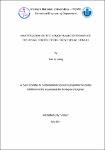| dc.description.abstract | The applications of Functional Near-Infrared Spectroscopy (fNIRS) are becoming extended and practical in many fields, especially in vivo research on human. Our study investigated the hemodynamic response of visual cortex under different condition of stimuli. Our work focuses on evaluating the effects of varying spatial frequencies and modulation depths of flickering light to the hemodynamic responses of the visual cortex and on detecting the activation of the visual cortex when a subject is watching a video. In the first experiment, the concentration of oxygenated hemoglobin in all data increased greatly when subject is watching flickering light. However, ANOVA analysis of spatial frequency and modulation depth factor found insignificant results. This results demonstrated that flickering light can change the hemodynamic response but those changes were not distinct among different stimulus condition. In the second experiment, classification algorithm was successfully detecting the activation of the brain. The fNIRS are capable of detecting unique hemodynamic responses of the visual cortex.
Key words: Near-infrared Spectroscopy (NIRS), visual cortex, flickering light, visual stimulus, video, SVM classification. | en_US |


